
Nordland is a county in Norway in the Northern Norway region, bordering Troms in the north, Trøndelag in the south, Norrbotten County in Sweden to the east, Västerbotten County to the south-east, and the Atlantic Ocean to the west. The county was formerly known as Nordlandene amt. The county administration is in the town of Bodø. The remote Arctic island of Jan Mayen has been administered from Nordland since 1995. In the southern part of the county is Vega, listed on the UNESCO World Heritage Site list.

Evenes (Norwegian) or Evenášši (Northern Sami) is a municipality in Nordland county, Norway. It is part of the traditional district of Ofoten. The administrative centre of the municipality is the village of Bogen. Other villages in Evenes include Liland, Tårstad, Dragvik, and the village of Evenes.

Mo i Rana is a city, and the administrative centre of the municipality of Rana, in Nordland county, Norway. It is located in the Helgeland region of Nordland, just south of the Arctic Circle. Some of the city's suburbs include Båsmoen and Ytteren in the north, Gruben in the south east, Selfors in the east, and Åga/Hauknes/Dalsgrenda in the south.

Sir Antony Mark David Gormley is a British sculptor. His works include the Angel of the North, a public sculpture in Gateshead in the north of England, commissioned in 1994 and erected in February 1998; Another Place on Crosby Beach near Liverpool; and Event Horizon, a multipart site installation which premiered in London in 2007, then subsequently in Madison Square in New York City (2010), São Paulo, Brazil (2012), and Hong Kong (2015–16).
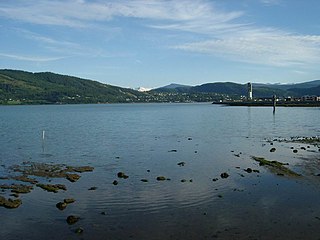
Rana is a municipality in Nordland county, Norway. It is part of the Helgeland traditional region. The administrative centre of the municipality is the town of Mo i Rana, which houses the National Library of Norway. Other population centers in Rana include Båsmoen, Dunderland, Eiteråga, Flostrand, Hauknes, Mæla, Myklebustad, Nevernes, Røssvoll, Selfors, Skonseng, Storforshei, Utskarpen, and Ytteren.
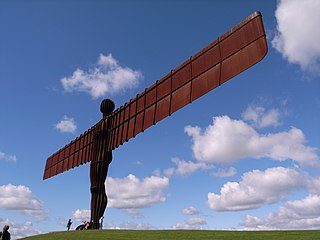
The Angel of the North is a contemporary sculpture by Antony Gormley, located in Gateshead, Tyne and Wear, England. Completed in 1998, it is believed to be the largest sculpture of an angel in the world and is viewed by an estimated 33 million people every year due to its proximity to the A1 and A167 roads and the East Coast Main Line. The design of the Angel, like many of Gormley's works, is based on Gormley's own body. The COR-TEN weathering steel material gives the sculpture its distinctive rusty, oxidised colour. It stands 20 metres (66 ft) tall with a wingspan of 54 metres (177 ft), larger than that of a Boeing 757 aircraft. The vertical ribs on its body and wings act as an external skeleton which direct oncoming wind to the sculpture's foundations, allowing it to withstand wind speeds of over 100 miles per hour (160 km/h).

The Nordland Line is a 729-kilometer (453 mi) railway line between Trondheim and Bodø, Norway. It is the longest in Norway and lacks electrification. The route runs through the counties of Trøndelag and Nordland, carrying a combination of commuter, long-haul passenger and freight trains. From Trondheim Central Station to Steinkjer Station the line is most heavily used, with hourly services by the Trøndelag Commuter Rail. There are three branch lines—the Stavne–Leangen Line at Leangen Station, the Meråker Line at Hell Station and the Namsos Line at Grong Station.
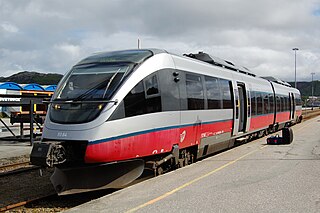
Class 93 is a tilting two-carriage diesel multiple unit used by SJ Norge for passenger trains on non-electrified stretches of the Norwegian railway network. Used on the Nordland Line, the Røros Line and the Rauma Line, they were purchased to replace the aging Di 3 locomotive-hauled trains. The Class 93 was produced by Bombardier, and is part of the Talent family. Fifteen units were delivered between 2000 and 2002.
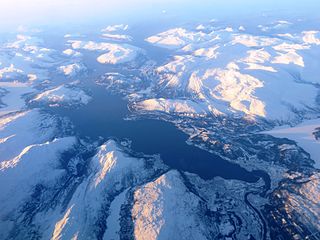
Ranfjorden is a fjord in the Helgeland district of Nordland county, Norway. The largest part of the fjord is in the municipality of Rana, but the fjord also passes through the municipalities of Hemnes, Vefsn, Leirfjord, Nesna, and Dønna. The Ranelva river meets the Ranfjord in at the town of Mo i Rana at the innermost part of the fjord. It then flows to the west for about 68 kilometres (42 mi) to where it meets the sea along the border of Dønna and Nesna municipalities.

Sør-Rana is a former municipality in Nordland county, Norway. The 777-square-kilometre (300 sq mi) municipality existed from 1929 until 1964. Sør-Rana encompassed an area on both sides of the middle section of the Ranfjorden around where the Sørfjorden and Elsfjorden branch off the main fjord.

The Dunderland Line was a 23.7 km (14.7 mi) railway line between Gullsmedvik in the town of Mo i Rana and the village of Storforshei in Rana Municipality in Nordland county, Norway. Since 1942 the line has been part of the Nordland Line. The line was originally built and owned by Dunderland Iron Ore Company, which used it to freight iron ore from their mine at Storforshei to the port at Gullsmedvik.

Selfors is a village in the municipality of Rana in Nordland county, Norway. Selfors sits on the northern shore of the river Ranelva and it is a northeastern suburb of the town of Mo i Rana. The European route E06 highway passes through the village. Selfors has been inhabited since the Iron Age.
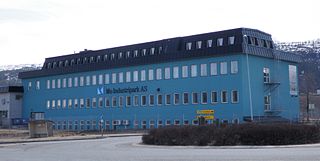
Mo Industrial Park is one of Norway's largest industrial parks, situated in the town of Mo i Rana, North Norway. The company Mo Industrial Park produces oxygen, nitrogen and compressed air, and also provides security, telephone-switchboard and mail services to the other companies in the park. The companies engage in a wide range of activities, including iron and steel production, ferroalloy production, workshop industry, service industry, research, quality and computer technology, expertise industry, and even fish farming. Total gross income is close to 4 billion NOK per year.

The Peter the Great Statue is a 98-metre-high (322 ft) monument to Peter the Great, located at the western confluence of the Moskva River and the Vodootvodny Canal in central Moscow, Russia. It was designed by the Georgian designer Zurab Tsereteli to commemorate 300 years of the Russian Navy, which Peter the Great established. It was erected in 1997 and It weighs around 1,000 tons containing 600 tons of stainless steel, bronze and copper.

The Meeting Place is a 9-metre-high (30 ft), 20-tonne (20-long-ton) bronze sculpture that stands at the south end of the upper level of St Pancras railway station. Designed by the British artist Paul Day and unveiled in 2007, it is intended to evoke the romance of travel through the depiction of a couple locked in an amorous embrace.

Helgeland Kammerkor is a mixed choir from the region of Helgeland in Northern Norway. The choir was founded in Sandnessjøen i 1992, and currently has around 30 members. The members of Helgeland Kammerkor meet once a month for rehearsals, and give concerts 4-5 times a year. The choir has a broad repertoire that includes church music, madrigals, Nordic folk music and large concert works such as Carmina Burana by Carl Orff. From 2009 to 2018 the choir was conducted by Christopher Eva.
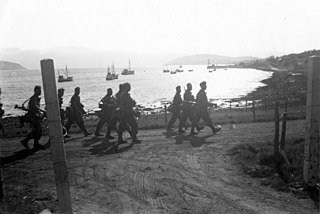
The Actions in Nordland were part of the 1940 Norwegian Campaign of World War II. They were a subsidiary part of the Allied attempt to recapture Narvik.

LOOK II is a permanent sculpture by British sculptor Antony Gormley on the south-western leg of West Hoe Pier, Plymouth, Devon, England.
Mo i Rana Airport, Fagerlia is a regional airport under construction, which will serve the town of Mo i Rana in the municipality of Rana and surrounding municipalities in Nordland county, Norway. The airport will be located about 10 kilometres (6.2 mi) outside the town.
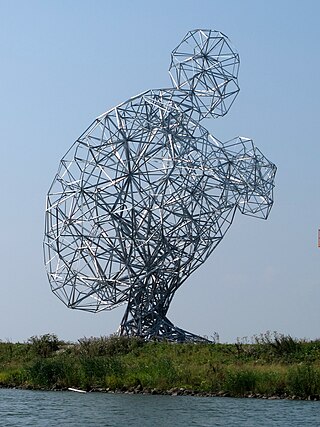
Exposure (Exposure) is a steel frame sculpture on the Markerstrekdam near the Houtribsluizen in Lelystad Netherlands by artist Antony Gormley. The work is also known as Crouching man, or popularly called the Shitting Man.



















